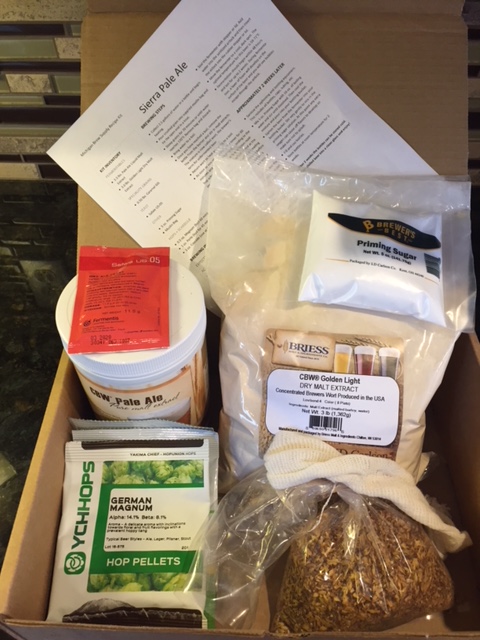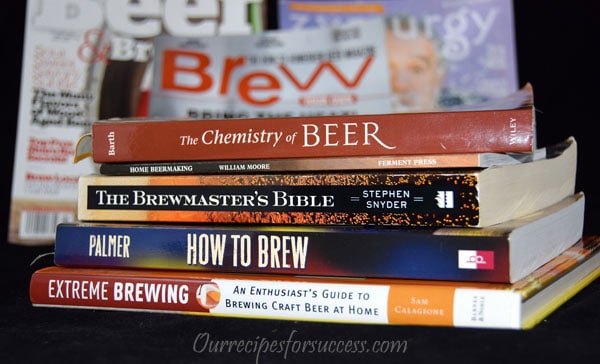If you’re reading this, you’re probably trying to decide whether you should start brewing beer at home. Is homebrewing expensive? Is homebrewing complicated? Will I be able to make good tasting beer? I believe if you read on, I can convince you to give it a try. There’s nothing to fear and you definitely can make good tasting beer.
In this article, we will be providing you with a few links to some products for pricing and informational purposes. We are required to let you know some of these links are “affiliate links”. This means if you click on a link and make a purchase, we could make a small commission, at no extra cost to you. This helps offset the cost of maintaining our website. Now, let’s get started.
Reasons to Start Brewing Beer
Table of Contents
There are several good reasons many folks start homebrewing. Below are the main reasons why I decided to get into beer brewing and I haven’t regretted it yet.
Reason #1
The obvious reason is that you like beer! Not just any beer… craft beer. Most light beer drinkers are not too fond of the higher hop contains or the stronger flavors of the darker craft beers. But if you do, there is no better or rewarding hobby out there! Craft beers come in many styles and many different, unique flavors. You can pair your beers nicely with different foods, much like a good wine, and there are beers made for different seasons. There is something for every craft beer lover and this is where the journey begins!
Reason #2
Another factor is the cost of craft beer. You can typically buy a 12 pack of Bud Light for the same price many craft beer makers charge for a 6 pack. After you make the initial investment in your brewing equipment you can make it for much less. A typically 5 gallon batch of homebrew, costing approximately $40, and will yield about 2 cases of beer. At an average of $9 a six-pack for craft beer, that’s over $70. That’s a 40% saving! Homebrew supply shops and internet stores have a wide variety of recipe kits and ingredients, and you can find “clone” recipes for most of your favorite craft beers on the internet.
Reason #3
If you are anything like me, you are a Do-It-Yourself person. I enjoy making my own venison sausage. My wife makes her own raspberry salsa, stewed tomatoes, and a family hot dog relish recipe and canning them. Could we buy all these things? Sure we could, but all of these recipes have been handed down, altered, and tweaked, and are now our own! It’s the same with homebrewing beer. You’ll find your favorites and make them your own. I found a nice porter recipe I enjoyed and, for a little variation, added a little vanilla to it. It turned out great. Brewing your own beer allows you the freedom to experiment, have fun and drink some great beer.
Reason #4
As a DIY person, learning how to do new things is very rewarding. To become good at beer brewing you’ll want to do a little research. Following the recipes and brewing the beer is pretty straightforward. Getting a better understanding of the science behind brewing beer will help you fine-tune your process. As you learn you’ll know what role temperatures play throughout the brewing process. You’ll find out what keeps your yeast health. Learning and personal growth are as important as the brewing and the great beer you’ll make!
Reason #5
Sharing your beer with family and friends is more fun than making it. They will truly be impressed by your creations. After you have a few batches made host a “beer sampling” party. Invite them to join you when you brew. There are many ways to share the experience. Once you find out what they like, a six-pack of homebrew makes a great gift too!
Reason #6
Getting started is not that expensive. Below I’ve laid out the basics of getting started. What equipment you’ll need to give brewing a try. What ingredients you’ll need and where to get them. I’ve even included some “brew day” tips to help you out. It really is easy and inexpensive to give it a try.
Reason #7
And finally, once you have the equipment and have a better understanding of the brewing process, you can expand into other beverages. Using much of the same equipment I have made wine and a couple of batches of mead. Am I going to win an award? Maybe not, but both were tasty and I think they’ll only get better going forward. And there will be more!
Beer Brewing Equipment Needed To Start
To get started you’re going to need some basic equipment. You may already have some of it, but you’ll definitely need to purchase some. At the side is a list of the basic equipment you would need to get started brewing beer. You can find a lot of this equipment on eBay and Craig’s List.
If you’d rather stick with new equipment, it can be found at brew shops and online. Buying a starter kit may be a good option. Be sure to do some price comparisons. Online stores often have special offers. I found one on sale at Amazon that looked hard to beat. Click this link to check the price. It includes a brew kettle and a recipe kit. The point being, be sure to shop around.
Basic Brewing Equipment Needed
Basic Brewing Supplies Needed
Beer Brewing Ingredients
Starting out, you’re probably not going to be able to create your own recipes. Recipes are actually a complex blend of hops and malts. The bitterness of the hops offsetting the sweetness of the malts. Then you throw in specialty grains and the different yeast strains and the flavor combinations become endless. I believe starting out by using ingredient kits is the best way to go.
Most kits come with everything you’ll need for brewing your beer. That includes complete instructions and all the ingredients. Click on the links to these two beer brewing suppliers (Michigan Brew Supply Midland, Michigan, and Northern Brewer) to get an idea of some of the different kits that are available and to compare prices. There are lots to choose from. After you get comfortable with the brewing process itself, then you’ll be more inclined to try some different recipes and start experimenting.
Basic Brew Day Tips
If you are just getting into home brewing beer, again I highly recommend using an ingredient kit. Most kits have pretty good instructions. They’ll explain when to add the different ingredients; how long to boil the wort; when to cool the wort; when to pitch the yeast; and how long to ferment. The instructions will walk you through adding the priming sugar and bottling your beer too. I’d like to share a few basic items that will help make your brew day go a little smoother.
Tip #1
Make sure your kettle is large enough! The kettle should be large enough to boil at least 3 to 4 gallons of wort. Once the water is boiling, remove it from the heat and slowly stir in the malt extract. This helps to keep the sugary mixture from scorching on the bottom of the kettle. This can cause the wort to darken, which affects the color of your finished beer. This is very important when brewing a lighter colored beer. You’ll want to allow at least 6”-8” of space after adding the water and malt extract to the kettle. As the wort boils this mixture tends to want to foam up and can easily boil over. If you stir it frequently and leave enough space you’ll be fine.
Tip #2
After boiling cooling the wort rapidly is very important. It helps to drop out solids and allows you to pitch the yeast quicker, without harming it. The less time the wort is exposed to the air the better. The wort is very susceptible to contamination at this point. Most beginning brews cool their wort by placing it in a sink, or tub, of cold ice water. I did it and it does work. What you need to know is it will take you at least 20 to 30 minutes and you will use a lot of ice! A couple of ice cube trays will not be enough! I would usually save a couple of plastic grocery bags full of ice prior to brewing day or buy a couple of bags.
Tip #3
At this point in the process (wort being cooled), anything that will come into contact with the wort must be sanitized! That includes spoons, thermometers, fermentation buckets/carboys, and even the outsides of the yeast packaging. Again, the wort is highly susceptible to infection at this point. I have written an article dedicated to the proper cleaning and sanitizing of your brewing equipment. Please consider reading it to help make your homebrewing experience successful.
Tip #4
Once your wort has been cooled, the yeast has been pitched, and it’s all sealed up in the fermentor, find a nice cool spot to let the yeast do its job undisturbed. A basement or storage room that is around 70 degrees or a little less will work fine. It’s important to keep the temperatures down during fermentation or off flavors can develop.
Bottling
After a week or two, the fermentation should be complete and there will not be any signs of bubbling in the airlock. You are now ready to bottle your beer. That’s right, it now has alcohol in it, so it’s official beer. Be sure to clean and sanitize your bottles, caps and all the equipment that will be used in the bottling process. I have a spray bottle with sanitizer handy I use to sanitize the bottle capper or anything that may have become inadvertently contaminated.
Dissolve the recommended amount of priming sugar in 2 cups of boiling water, let it cool down a bit, and then gently stir it into the bottling bucket. Now fill your bottles and cap them. That’s all there is to it. Let them sit for one or two weeks, so the yeast can process the priming sugar and produce just enough CO2 to nicely carbonate your beer. After that chill them and enjoy!!
Let’s Get Started
Brewing beer isn’t difficult. Start out with the basics. Follow the brewing instructions, implement my tips, and you will have no problem getting started. I consider myself an “experienced beginner”. I have not gone into all-grain brewing and in fact, quite often still use recipe kits. The ingredients are fresh, they have everything you need, and it makes the process that much easier. Oh yeah, did I mention they make pretty good Beer?! Amazon has very competitive beer kit prices. Check out this Amazon amber ale kit price and compare it to one from the Michigan Brew Supply Store in Midland, Michigan. Both places have a large selection of good-quality kits. The kit pictured below is a pale ale kit I purchased from Michigan Brew Supply and it

Beer Brewing Resources
I have read several books on homebrewing and highly encourage anyone starting out to do the same. Books, magazines, and online forums and blog articles are great resources for information. Educating yourself in the craft will be one of your greatest investments you make in beer brewing. Below are some of the books and magazines I have read and recommend.

Books
How To Brew – Everything You Need to Know to Brew Great Beer Every Time by John J. Palmer This is a great book for all skill levels. “How To Brew” Kindle version.
The Brew-Masters Bible by Stephen Snyder This is a great book for all skill levels.
Home Beermaking – The Complete Beginner’s Guidebook by William Moore
This is a great book little book for beginners.
Extreme Brewing by Sam Calagione
This is a great book for all skill levels. “Extreme Brewing” Kindle version.
The Chemistry of Beer: The Science in the Suds by Roger Barth This book is tailored to a more advanced chemistry audience. It still has a lot of good information and would definitely be a great resource on your homebrewing journey. “The Chemistry of Beer” Kindle version.
Magazines
Brew Your Own magazine The How-To Homebrew Beer Magazine (subscriptions available through Amazon at discounted prices)
Conclusion
Since I’ve started brewing I have added additional equipment to my arsenal. This equipment has made the process easier and helps save time. This link is to some beer brewing posts I’ve written, which can help you when getting started and in the future. They include some yeast preparation tips and a typical extract brew day, just to name a couple. Check them out.
I highly recommend that you do a little research and give homebrewing a try. It’s rewarding and I believe you’ll enjoy it. Maybe you can enjoy one of your own homebrews while reading my next article on homebrewing!
If you have any comments or questions, you can leave them in the comments section below or you can email us at [email protected]. FYI, we do not collect or share email addresses. We will only use them to reply to your comments or provide answers to your questions. We are also required to let you know that some of our links are “affiliate links”. This means if you click on a link and make a purchase, we could make a small commission, at no extra cost to you. This helps offset the cost of maintaining our website. So, if you like what you’ve seen, please be sure to give us a “Like” and “Share” on Facebook and Instagram too. Thank you for reading and good luck with all your home projects!


It’s a great hobby! Playing around with flavors and creating your own signature blend is so much fun!